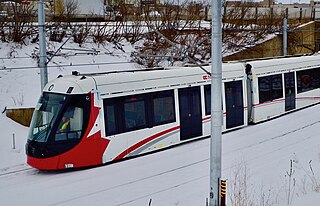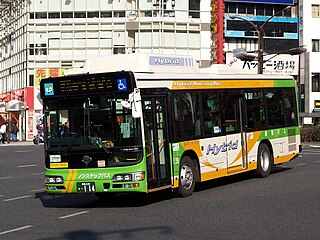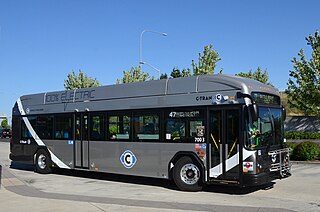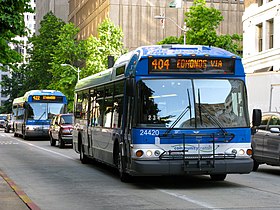
OC Transpo is the organisation that operates and plans public transport in the city of Ottawa, Canada. OC Transpo runs bus rapid transit, light rail, conventional bus routes, and door-to-door paratransit.

The Mercedes-Benz Citaro is a single-decker, rigid or articulated bus manufactured by Mercedes-Benz/EvoBus. Introduced in 1997, the Citaro is available in a range of configurations, and is in widespread use throughout Europe and parts of Asia, with more than 55,000 produced by December 2019.

The Toronto Transit Commission (TTC) uses buses and other vehicles for public transportation. In 2018, the TTC bus system had 159 bus routes carrying over 264 million riders over 6,686 kilometres (4,154 mi) of routes with buses travelling 143 million kilometres in the year. As of 2021, the TTC has 192 bus routes in operation, including 28 night bus routes. In 2023, the system had a ridership of 362,041,400, or about 1,179,700 per weekday as of the third quarter of 2024.
The MTA Regional Bus Operations bus fleet is a fleet of buses in fixed-route service in New York City under the "MTA New York City Bus" and "MTA Bus" brands, both of which operate local, limited, express and Select Bus Service routes.

Van Hool NV is a Belgian coachbuilder and manufacturer of buses, coaches, trolleybuses, and trailers.

A hybrid electric bus is a bus that combines a conventional internal combustion engine propulsion system with an electric propulsion system. These type of buses normally use a diesel–electric powertrain and are also known as hybrid diesel–electric buses.

Ride On is the primary public transportation system in Montgomery County, Maryland. Managed by the Montgomery County Department of Transportation, Ride On serves Montgomery County as well as the community of Langley Park in Prince George's County and Sibley Memorial Hospital in Washington, D.C. In fiscal 2018, it operated on a US$112.3 million budget. In 2023, the system had a ridership of 16,644,600, or about 59,800 per weekday as of the third quarter of 2024.

The Orion VI was a low-floor transit bus available in 40' lengths manufactured by Ontario Bus Industries between 1995 and 2003. The Orion VI was intended to provide an alternative to the existing high-floor Orion V; both the V and VI were replaced by the partially low-floor Orion VII.

The Orion VII is a line of low-floor transit buses available in 30' rigid, 35' rigid, and 40' rigid lengths manufactured by Daimler Buses North America's subsidiary Orion Bus Industries between 2001 and 2013 in three generations. The conventional powered buses, either with longitudinally-mounted diesel or natural gas engines, used a T-drive transmission coupling. A series hybrid variant powered by a diesel-driven generator was also available. The Orion VII replaced the fully low-floor Orion VI and high-floor Orion V buses, and was manufactured until its parent company DaimlerChrysler withdrew from the transit bus market in 2013.

The MAN Lion's City is a range of low-floor and low-entry public buses built by German truck and bus manufacturer MAN Truck & Bus since 1996 primarily for the European market, but is also available in chassis-only variants worldwide. The name Lion's City has been used since 2006, when MAN's public bus models which had been marketed separately were gathered into one range, when also most models received a facelift. The first models to be introduced were the 12-metre low-floor intercity bus NÜ xx3 (A20) in 1996, the 12-metre city bus NL xx3 (A21) in 1997 and the articulated NG xx3 (A23) in 1998. As with former MAN bus models the power-rating made up part of the model name, giving the NÜ-series buses with power-ratings of 260 and 310 hp model names NÜ 263 and NÜ 313 respectively. The main production sites are in Starachowice and Sady in Poland, but the models have also been built in Germany, Turkey and Malaysia. Initially most of the midibus variants were manufactured by Göppel Bus in Augsburg, later Nobitz.

The Gillig Low Floor is a transit bus manufactured by Gillig since 1997. The second low-floor bus design introduced in the United States, the Low Floor originally served as a second product range for the company alongside the Gillig Phantom. As transit bus operators shifted toward low-floor designs, the Low Floor has replaced the Phantom entirely, becoming the sole vehicle platform offered by the company since 2008.

The Low Floor Series (LFS) is a series of transit buses manufactured by Nova Bus for North American customers from 1996 to the present. It is produced in 40' rigid and 62' articulated (nominal) lengths with a variety of powertrains, including conventionally-fueled, hybrid diesel-electric, and battery-electric. The LFS is the first transit bus designed by Nova Bus.

The New Flyer Xcelsior is a line of transit buses available in 35-foot rigid, 40-foot rigid, and 60-foot articulated nominal lengths manufactured by New Flyer Industries since 2008. In addition to the different available lengths, the buses are sold with a variety of propulsion systems: conventional diesel, compressed natural gas (CNG), diesel-electric hybrid, hydrogen fuel cell, overhead electric wire and battery electric. A future autonomous bus variant was announced in January 2021.
As of 2019, King County Metro operates the seventh largest fleet of buses in the United States, with a total of 1,583 buses. The agency's buses traveled a total of 53 million miles (85,000,000 km) and transported over 123 million passengers in 2019.

New Flyer is a Canadian multinational bus manufacturer, specializing in the production of transit buses. New Flyer is owned by the NFI Group, a holding company for several bus manufacturers. New Flyer has several manufacturing facilities in Canada and the United States that produce the company's main product, the New Flyer Xcelsior family of buses.

The New Flyer Low Floor is a line of low-floor transit buses that was manufactured by New Flyer Industries between 1991 and 2014. It was available in 30-foot rigid, 35-foot rigid, 40-foot rigid, and 60-foot articulated lengths. In addition to the different available lengths, the buses were sold with a variety of prime movers, ranging from conventional diesel and CNG combustion engines to diesel-electric hybrid, gasoline hybrid, and hydrogen fuel cell.

The NABI LFW is a line of low-floor transit buses available in 30' rigid, 35' rigid, 40' rigid, and 60' articulated lengths manufactured by North American Bus Industries (NABI) between 1997 and 2015. In addition to the different available lengths, the buses were sold with a variety of powertrains, including conventional diesel, LNG, and CNG combustion engines along with a diesel-electric hybrid system

The NABI BRT is a line of low-floor transit buses available in 60' articulated (60-BRT) and later 42' rigid (42-BRT) nominal lengths manufactured by North American Bus Industries (NABI) between 2004 and 2015. In addition to the different available lengths, the buses were sold with a variety of prime movers, ranging from conventional diesel and CNG combustion engines to diesel-electric hybrid.

The ENC Axess is a line of low-floor transit buses available in 35-foot and 40-foot nominal lengths manufactured by ENC in Riverside, California starting from 2003. In addition to the different available lengths, the buses are sold with a variety of prime movers, ranging from conventional diesel, LNG/CNG combustion engines, diesel-electric hybrid and hydrogen fuel cell with a traction motor.

The ENC E-Z Rider and its successor E-Z Rider II are a line of low-floor, mid-sized, heavy-duty transit buses available in 30', 32', and 35' nominal lengths manufactured by ENC in Riverside, California starting from 1996. In addition to the different lengths, the buses are available with several powertrain options including traditional diesel, CNG, LNG, Propane, and diesel-electric hybrid.




















